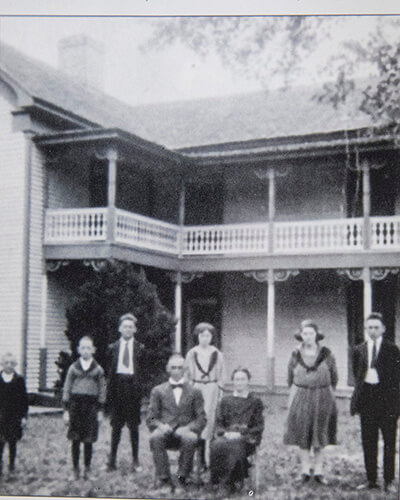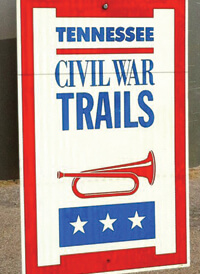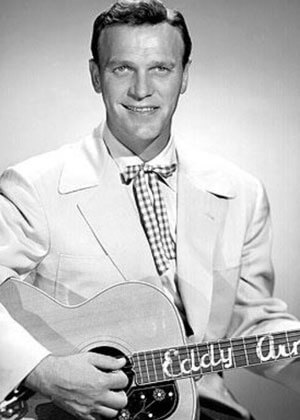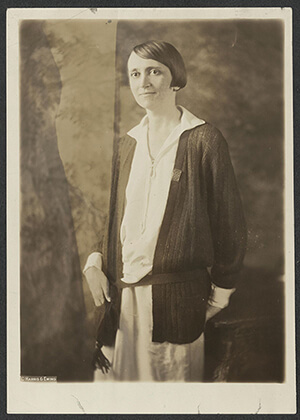History
EST 1879
Henderson, the seat of Chester County, is located in the central southwest area of the state, about 85 miles northeast of Memphis, 135 miles southwest of Nashville and 15 miles southeast of Jackson. The history of Henderson began in 1857 when the Mobile and Ohio Railroad was being constructed. At that time, the only cleared land in the area consisted of farms. In 1860, a few families from Henderson County moved into the area.
A depot was built by the railroad company, and the town’s businesses sprang up near the depot and railroad tracks. Mr. W.P. “Polk” Bray built the first business house in the fall of 1860 on what was called Front Row, now known as Front Street. At that time, the town was known as Dayton, a name it kept until after the Civil War. Building was slow until after the war. Only two or three businesses were here when the Civil War started, all of them located on Front Row. The war brought the building of the town to an abrupt halt. During the war the small town was occupied by Union troops protecting the depot.
Immediately after the war, building activities resumed, and the name of the community was changed from Dayton to Henderson’s Station, but finally shortened to Henderson.
This probably occurred because most of the people settling here were from the neighboring Henderson County. In 1870, there were about a half-dozen stores here, and in 1871, houses began to spring up in different places. In 1873, Dr. J.D. Smith Sr., who owned most of the land in the area, began to lay out streets and sell lots. A map made by a Philadelphia firm in 1877 showed the location of all the business houses and home owners in the rapidly growing town.
The majority of Henderson’s businesses were located just off of Front Street and along Main Street, where the downtown area is today. On South Washington and Union Streets, there were also clothing stores, a millinery shop, creamery, barber shop, feed store, livery stable and blacksmith shop. A grocery store, drug store, dry goods store and a hardware store quickly sprang up. By 1877, several business firms were being run by J.D. Smith Jr., Case O’Neal, R.J. Barham, T.H. Bagwell, Dr. T.A. Smith, H.D. Franklin, A.S. Saylor and John West.
On West Main Street, across the railroad (which did not have a bridge over it) was a hotel and rooming house owned by a Mrs. Conyers that later became the Woodard Hotel. The First Baptist Church was on a lot where the City Cemetery is now. After the formation of Chester County in 1879, the location of the county seat was left to popular vote. Two towns, Henderson and Montezuma, were placed in nomination. In 1882, an overwhelming majority of the electorate chose Henderson. On March 11, 1901, Henderson was incorporated by an act of the Tennessee legislature. The population at that time was about 1,000. A city council was elected. J.B. Hardeman was elected the first mayor. H.C. Ashcraft was chosen city recorder, and M.J. Ozier was named city attorney. Soon after the incorporation, a sewage system was installed and sidewalks and water works were built, but it was still several years before the streets were paved. Telephone service arrived with the Cumberland Telephone Company in 1898, and electricity arrived around 1915. Henderson has had three county courthouses. The present one is listed on the National Register of Historic Places and was built circa 1914.
Henderson has made its name on the national stage more than once. Although neighboring McNairy County was home to the legendary Sheriff Buford Pusser, his biographical movie, “Walking Tall,” was filmed in Chester County. You can still find several locals who were used as extras in the film. When Tennessee was honored at the Smithsonian Institution Folklife Festival in 1986, Henderson residents Waynell Jones and Bill and Minnie Howard were the featured experts on blues music and open-pit barbecue cooking. Country music superstar Eddy Arnold called Henderson home, as does 2002 American Idol finalist George Trice.
A few must-sees for the resident and visitor include Bell’s Drive-In, winner of the Tennessee Electric Cooperative’s “Best Burger This Side of Heaven” award for six consecutive years; Chickasaw Golf Course, the Jack Nicklaus-designed golf course; Chickasaw State Park, just nine miles west of town and historic architecture. If you come in the fall, enjoy the annual Chester County Barbecue Festival held on the Courthouse lawn. Let it be said that Henderson is truly a great place to visit and a grand place to live!

HISTORIC FRONT STREET
During the War, there was a major Confederate States of America recruitment center located along what is now Front Street, and the 51st and 52nd Tennessee Infantry were raised here. The Railroad Depot and the area around it was occupied by Union forces after the infantry’s departure.
Today, you can find the street continuing to thrive with unique shops like Front Street Farmhouse, LaVon’s Timeless Treasures, Happy Kids Consignment and Robertson’s Trading Post.
WALKING TALL
In 1973, the legacy of McNairy County Sheriff Buford Pusser was preserved in film when “Walking Tall” was filmed in Henderson and Chester County.
Many Henderson residents served as extras or played bit parts in the film that launched several sequels.


CIVIL WAR TRAIL MARKERS
During the Civil War, Henderson was a stop on the Mobile and Ohio Railroad line. At first, the small village consisting of houses and stores was named Dayton, but later it was changed to Henderson Station. After Fort Donelson’s fall in February 1862, Governor Isham G. Harris ordered Confederate militia from Benton, Carroll, Decatur, Gibson, Hardeman, Hardin, Henry, Madison, McNairy and Weakley counties to “rendezvous at Henderson Station.”
Today, you can find Civil War trail markers on the Courthouse lawn and on Historic Front Street.

EDDY ARNOLD
Known as the Tennessee Plowboy, Arnold spent his early years on a Chester County farm. His long, distinguished musical career led him from the cotton fields to the Grand Ole Opry, the Country Music Hall of Fame, the White House and Carnegie Hall. He charted top hits for more than half a century. Altogether, Arnold sold more than 85 million records, making him one of the most successful artists of the 20th century. RCA Records released his 100th album, “After All These Years,” in 2005.
“Eddy Arnold sold 85 million records,” Jimmy Melton, local musician and songwriter successfully pursuing a musical career in Nashville, said. “What makes that even more impressive is the fact that his early hits were during World War II, when rationing was underway. He sold so many that they ran out of shellac at the record pressing plant.”
“Eddy had a voice that competed easily with the pop stars of the day. He eased from hillbilly music into mainstream and had a second career in the ’60s. In addition to music, he had an outstanding career in real estate,” Melton continued. “Not bad for a farm boy from Henderson, Tennessee.”
Launched by the Tennessee Department of Tourist Development in 2018, Tennessee Music Pathways is an online planning guide that connects visitors to the state’s rich musical heritage at tnmusicpathways.com. From the largest cities to the smallest communities, Tennessee Music Pathways stretches across all 95 counties and features hundreds of landmarks from the seven genres of music that call Tennessee home: blues, bluegrass, country, gospel, soul, rockabilly and rock ‘n’ roll. Historians identified more than 300 points of interest to date, and additional markers will be installed for years to come.
In 1944 Arnold cut his first record, “Each Minute Seems a Million Years,” which became his first charting record. In 1945, he recorded “Cattle Call.” Although not a hit at the time, it became his theme song.
In 1946, he recorded “That’s How Much I Love You.” Within the next four years, his recordings included “Anytime” and “I’ll Hold You in My Heart,” which sold over a million records. The single spent 46 weeks on the charts, with 21 of those at the top; it also crossed over to the pop charts, reaching the Top 30. In the process, it became the number one single of the decade. It had been 11 years since he “lit out” from Chester County.
Arnold became a familiar face in the early ’50s, not only to country fans but also to the general public. He toured all of the U.S. and several foreign countries and was the first country star to have his own television show, “Eddy Arnold Time.” His string of Top 10 hits remained unbroken. The number of country hits remains amazing to this day: seven in 1950 and 13 in 1951.
Despite a drop in hits for a period of time in the late ’50s and early ’60s, Arnold began a new era of dominance in 1965 with “What’s He Doing in My World.” Not only did he return to the top of the country charts, he once again crossed over to the pop charts. Arnold’s second streak of major hits ran until 1969. During this time, he earned several number one and Top 10 singles, all of which were pop hits as well, including “Make the World Go Away” and “The Last Word in Lonesome Is Me.” The crossover hits led to Arnold’s being credited with creating the Nashville Sound. Hits were fewer in the ’70s and ’80s, but he did have three in the ’70s and two in the ’80s, making him one of the few artists who charted in seven different decades.

SUE SHELTON WHITE
Suffragist, attorney, writer and politician, Sue Shelton White rose from being the orphaned daughter of Chester County teachers to become one of the state’s and nation’s leaders in the fight for women’s rights, particularly the right to vote. Generally referred to as “Miss Sue,” her petite size belied her considerable abilities and will. James Tate, general counsel for the federal Social Security Board, called her “a lady warrior” – both a Southern gentlewoman and a fighter.
Unlike many suffragists who came from affluent backgrounds, White was born May 25, 1887, in Henderson, Tennessee, to James Shelton White and Mary Calista Swain. Her parents were schoolteachers of modest means and were considered by some to be liberal thinkers.
The death of James White in 1893 left Mary White responsible for the support of her seven children. She sold books and pianos, gave music lessons and wrote for the local newspaper. She also tutored her own children. The family lived in what Sue White described as a “twilight zone” between white Henderson and the Black community of Jaybird. Mary White died in 1901, leaving her daughter an orphan at age 14.
White graduated from Georgie Robertson Christian College in 1904 and West Tennessee Business College in Dyer, Tennessee, in 1905. At age 18, she began working as a stenographer in Jackson; a few years later she became one of the state’s first female court reporters.
From that beginning, she forged her way to the forefront of the women’s suffrage fight. Joining the movement in 1912, she became the recording secretary of the Tennessee Equal Suffrage Association in 1913 but switched her allegiance to the National Woman’s Party in 1918. She moved to Washington, D.C., and became Tennessee chair of the NWP and edited The Suffragist, the organization’s newspaper.
In Washington, White participated in a demonstration on the White House lawn and burned a paper effigy of President Woodrow Wilson. She was arrested and served five days in jail. Following her release, she joined the “Prison Special,” a train that traveled the country calling attention to the cause of women’s suffrage. Twenty-six members of the National Women’s Party traveled around the country. When they arrived at their destination, they put on uniforms like the ones they had worn in the workhouse for their public appearances. Speaking to large crowds, they described their treatment and the conditions in the prison.
After the U.S. Senate passed the 19th Amendment in June 1919, it was sent to the states for ratification. A little over a year later, 35 states had ratified it. Only one more state was needed to make it law. Eight southern states had already defeated ratification; Tennessee’s General Assembly would decide the Amendment’s fate. White returned to her home state to lead the fight. Tennessee, by a single vote, ratified the Amendment Aug. 18, 1920.
As clerk and later secretary to Tennessee Senator Kenneth C. McKellar, White continued her fight for women’s rights. Having earned a law degree in 1923 from Washington College of Law, she returned to Tennessee in 1926 and practiced law in Jackson until 1930. When Franklin D. Roosevelt was elected president in 1932, White was appointed executive assistant to Mary Harrison Rumsey in the Consumers Division of the National Recovery Administration. During the Roosevelt years, she expanded political patronage for Southern women. White also helped create a women’s faction within the Democratic Party, contributing to Roosevelt’s winning coalition in 1932. She moved to the Social Security Administration in 1935 where she helped implement the Social Security Act.
White succumbed to cancer May 6, 1943, in Alexandria, Virginia. She is one of five suffragists depicted in a sculpture located in Nashville’s Centennial Park. The work of Alan LeGuire, it commemorates Tennessee’s role in ratification of the 19th Amendment. The City of Henderson has not only named the downtown park in White’s honor, but also has wrapped a utility box with highlights of her legacy.

BILL HOWARD
In 2006, Jacks Creek barbecue legend Bill Howard left this earth. For more than 50 years, Bill was known throughout Chester County as “The Barbecue King.” He began honing his technique for barbecue in the late 1940s, but his first claim to fame came in 1978 when he was asked to cook for the first Chester County Barbecue Festival. He continued making barbecue for the festival for many years.
In 1986, Bill and his wife, Helen, were honored with an invitation to attend the Smithsonian Institute’s American Folklife Festival in Washington, D.C. Helen, known locally for her pie-making skills, demonstrated Southern cooking and pie baking, while Bill introduced festival goers to “hickory cooked Howard’s Bar-B-Q” from Henderson, Tennessee. The hand-lettered sign promoting his demonstration at the event read “The Best in the West.”
The Smithsonian Folklife Festival features a different state and a different country each year. In 1986, Japan was celebrated alongside the state of Tennessee and its three grand divisions. The Howards proudly represented West Tennessee cooking traditions, and during their week-long stay, they also talked to people about growing and raising all their own food, including hogs.
With a farm, animals, and 14 children to tend to, the Howards had not traveled much outside West Tennessee. The trip to Washington, D.C., was the trip of a lifetime! As for selecting a team to represent the culinary traditions of West Tennessee, the Smithsonian couldn’t have chosen a better pair than Bill and Helen Howard.
Bill’s legacy continues both through the work he did with his son, Oliver, who helped him barbecue for various events all over West Tennessee and Alabama, and through those who watched and learned from him and have passed down barbecue techniques through the decades. Bill and Helen’s work ethic and love of community continues through their children: Jimmie Lee Howard, Dickey Willard Howard, Stella Marie (Howard) Garland, Robbie Faye (Howard) Jones, Lewis Oliver Howard, Fletcher Kelvin Howard, Wilma Colleen (Howard) Mallard, Tony Neal Howard, Corlis Regina (Howard) Bumpas, Rosa Elaine (Howard) Platt, Teresa Lynne Howard, Cassandra Monta Howard, Billene Leonice (Howard) Christy and Danny Terrance Howard.
Museums
Chester County Museum at the Chester County Library
1012 East Main Street, Henderson, TN. 38340
731-989-4673
FHU Roland Historical room
158 East Main Street, Henderson, TN. 38340
731-989-6651
The Eddy Arnold Collection Room
located inside the Henderson | Chester County Chamber of Commerce
587 East Main Street, Henderson, TN
Hours: M-F 8:00 am – Noon and 1:00 pm until 4:00
731-989-5222
Troy Plunk Art Gallery
158 East Main Street, Henderson, TN. 38340
731-989-6651
Nearby Historical Landmarks
Pinson Mounds State Archeological Park
460 Ozier Rd, Pinson, TN. 38366
731-988-5614
Shiloh National Military Park
1055 Pittsburg Landing Rd, Shiloh, TN. 38376
731-689-5696
Parkers Crossroads Battlefield
20945 Highway 22 N., Parkers Crossroads, TN. 38388
731-968-1191